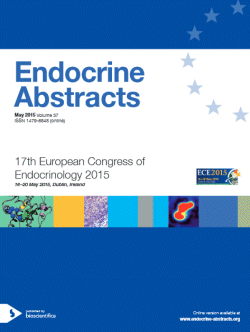Searchable abstracts of presentations at key conferences in endocrinology
Symposia
Adipose tissue as an endocrine organ (<emphasis role="italic">Endorsed by Endocrine Connections</emphasis>)
ea0037s14.1 | Adipose tissue as an endocrine organ (<emphasis role="italic">Endorsed by Endocrine Connections</emphasis>) | ECE2015
Adipose tissue turnover in humans
Owing to the increase in obesity, life expectancy may start to decrease in developed countries for the first time in recent history. In humans the generation of fat cells (adipocytes) is a major factor behind the growth of adipose tissue during childhood. The factors determining the fat mass in adults, however, are not fully understood. Increased fat storage in fully differentiated adipocytes, resulting in enlarged fat cells, is well documented and thought to be the most impor...
ea0037s14.2 | Adipose tissue as an endocrine organ (<emphasis role="italic">Endorsed by Endocrine Connections</emphasis>) | ECE2015
FGF1 and PPAR-γ in the Adipocyte
Survival requires the ability to adapt to cycles of feast and famine, yet the underlying mechanisms to maintain metabolic balance during extremes of nutrient excess remain poorly understood. We recently discovered that the classic growth factor FGF1 is induced in white adipose tissue (WAT) in response to high-fat-diet (HFD) and repressed during fastong, pointing to an unexpected metabolic function. Thus, FGF1 participates in both fed-state and fasted-state responses. In WAT, F...
ea0037s14.3 | Adipose tissue as an endocrine organ (<emphasis role="italic">Endorsed by Endocrine Connections</emphasis>) | ECE2015
Manipulating adipose tissue sensitivity to glucocorticoid excess
Glucocorticoids (GCs) have physiological actions in almost all tissues, classically mediated by the GC receptor. The potent effects of GCs upon metabolic phenotype are best exemplified in patients with circulating GC excess (Cushings syndrome), who develop central (visceral) obesity, insulin resistance, myopathy, hypertension and in some cases overt type 2 diabetes (T2DM) and non alcoholic fatty liver disease (NAFLD). GCs are one of the most frequently prescribed class o...




